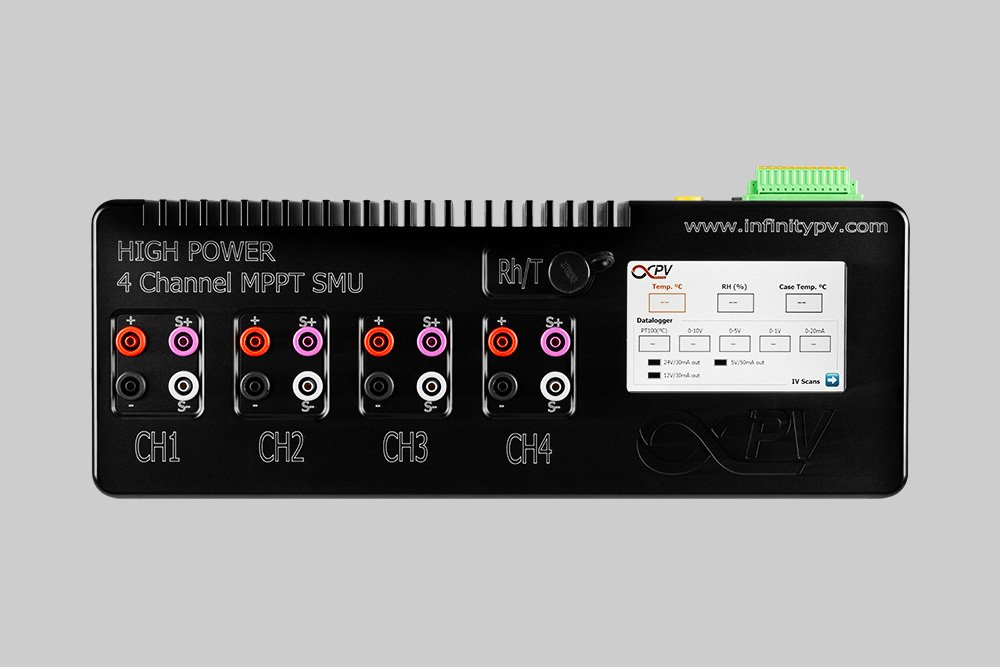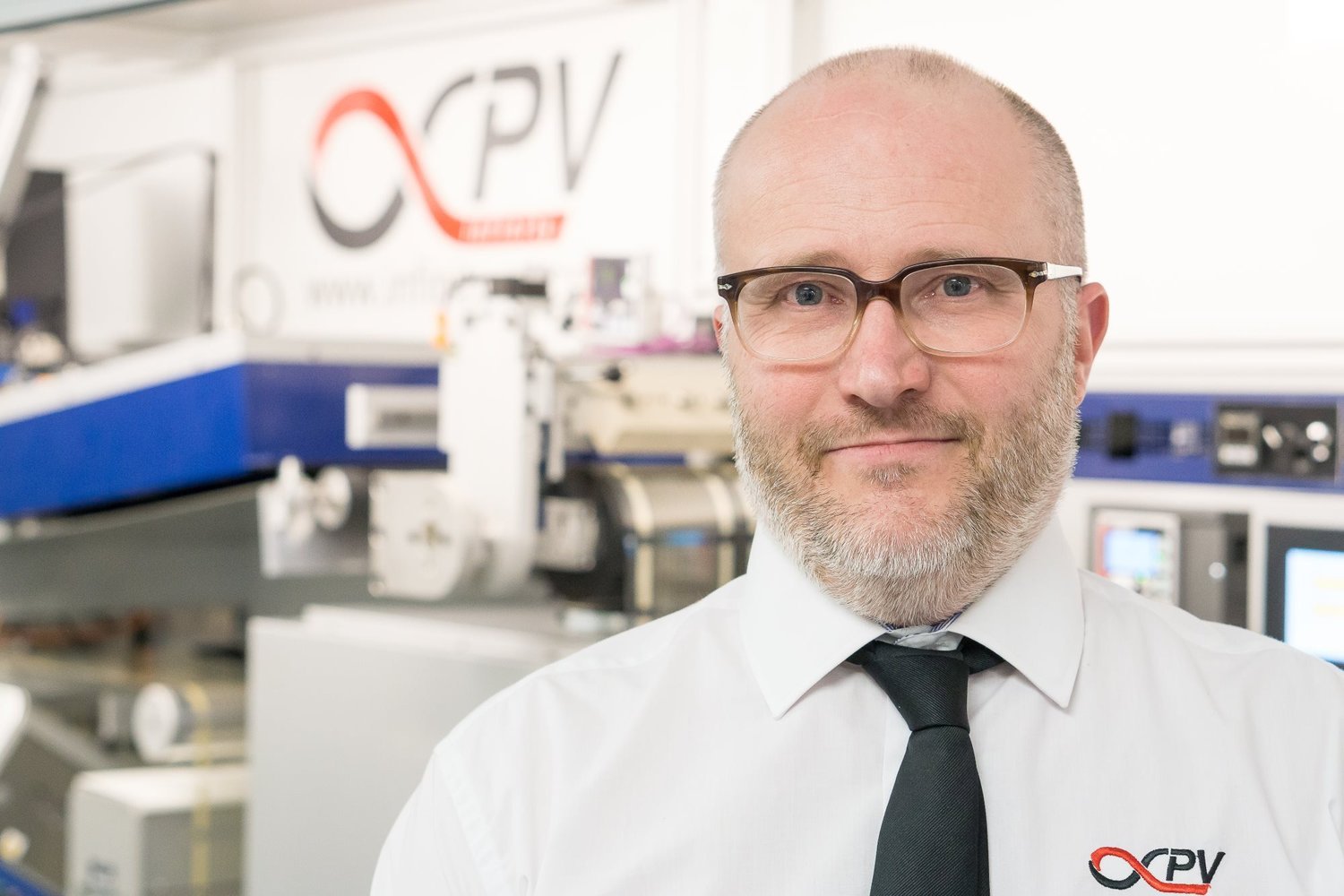What Is a Source Measure Unit (SMU)? Applications in Solar Cell and Semiconductor Testing
Example of a 4 Channel High Power SMU with MPPT Tracker.
What is an SMU?
A Source Measurement Unit (SMU) is a powerful instrument that combines precision power sourcing and measurement in one device. Widely used in electronics testing and material science, SMUs allow researchers to apply a defined voltage or current while simultaneously measuring the resulting electrical response. This dual functionality makes them essential for accurately characterizing semiconductors, solar cells, batteries, and optoelectronic devices, especially when detailed current-voltage (I-V) analysis and stability testing are required.
How Does an SMU Function?
An SMU operates by combining the ability to source and measure electrical power. It can output precise amounts of voltage or current based on user-defined settings while simultaneously measuring the resulting voltage or current flowing through the device under test (DUT). SMUs typically offer various control modes, including:
Voltage Source Mode: A specific voltage is supplied while measuring the resulting current.
Current Source Mode: A designated current is sourced while measuring the resulting voltage.
They feature advanced feedback mechanisms to ensure accuracy by automatically adjusting the output if measured values deviate from the desired set points. Additionally, many modern SMUs include data logging capabilities for recording measurements over time, which is particularly useful for research and development analysis. They can also be programmed for automated testing, facilitating integration into larger testing systems, making SMUs essential tools for precise electrical measurements and sourcing.
Rohde & Schwarz: Understanding Source Measure Units
Typical Applications of SMU Systems
SMUs are extensively used in various applications across different fields:
Semiconductors: SMUs are employed to characterize semiconductor devices like diodes, transistors, and MOSFETs. They facilitate the measurement of current-voltage (I-V) characteristics, which helps evaluate performance metrics such as threshold voltage, saturation current, and leakage current.
Solar Cells: In photovoltaic research, SMUs measure the I-V curves and maximum power points of solar cells. They help determine parameters like open-circuit voltage, short-circuit current, and fill factor, all crucial for evaluating solar cell efficiency.
Batteries: In battery research and quality control, SMUs characterize rechargeable batteries by measuring I-V curves during charging and discharging cycles, thus assessing capacity, charge retention, and efficiency.
LED and Optoelectronic Devices: SMUs are used to characterize light-emitting diodes (LEDs) and laser diodes by measuring their electrical characteristics while simultaneously monitoring optical output. This enables researchers to analyze performance under various conditions.
Using SMU Systems in Solar Cell Research and Development
SMU systems are indispensable for comparing and optimizing materials and processing steps for solar cell devices due to their ability to provide accurate measurements. They enable detailed analysis of performance metrics, allowing researchers to identify optimal materials and fabrication processes. SMUs also facilitate stability testing under various conditions and can conduct high-throughput testing to accelerate research and innovation. By systematically collecting data, SMUs support evidence-based decisions that ultimately lead to improved efficiency and performance of solar technologies.
Join our hands-on Printed Electronics Workshop and gain practical experience in every step of printed solar cell manufacturing, from ink preparation to testing and final integration.
How to Characterize Solar Cells using an SMU
Understanding the options and possibilities for characterizing solar cells with an SMU is essential for setting up effective experiments tailored to the study's objectives.
Measuring the Short-Circuit Current (Isc): The short-circuit current is defined as the current flowing through the solar cell when 0V is applied across its terminals. By configuring the SMU as a voltage source set to 0V (using the ammeter function), users can accurately measure the Isc of the solar cell connected to the channel.
Measuring the Open-Circuit Voltage (Voc): The open-circuit voltage (Voc) represents the maximum voltage a solar cell can produce, occurring when there is zero current. This voltage corresponds to the forward bias on the solar cell junction caused by the light-generated current. By setting the SMU as a current source of 0 amps (or opening the channel while measuring, using the voltmeter function), users can determine the Voc of the solar cell.
Measuring a Complete I-V Curve: The SMU can perform a voltage sweep from 0V (or a slightly negative voltage) to above the expected Voc, sinking the current generated by the solar cell. The I-V (Current-Voltage) curve is a critical diagnostic tool in solar cell research and industry as it provides essential performance parameters, reveals material properties, and helps identify defects. Here are some key points about its importance:
Extracting Key Solar Cell Parameters: The I-V curve directly measures:
Voc and Isc
Maximum Power Point (Pmax): The optimal operating point for power extraction.
Fill Factor (FF): Indicates the efficiency of charge extraction (higher FF = better cell quality).
Efficiency (η): The percentage of sunlight converted to electricity (η = Pmax / Input light power).
Revealing Electrical Behavior & Loss Mechanisms:
The shape of the I-V curve can indicate dominant loss mechanisms:
Low FF? → High series resistance (Rs) or shunt leakage (Rsh).
"S-shaped" curve? → Carrier transport barriers (common in perovskites).
Low Voc? → High recombination due to defects or poor contacts. This information helps engineers optimize materials, interfaces, and device structures.
I-V Time Studies: The SMU can conduct long-term studies by periodically tracing the I-V curve of the solar cell, saving data for analysis and performance tracking over time. The state of the cell between measurements depends on the study's objective and the degradation mechanisms being analyzed. Common approaches include:
Open-Circuit Condition (Voc): The solar cell is illuminated but without an external load, mimicking real-world conditions when a solar panel is not generating power. This helps study degradation mechanisms such as potential-induced degradation (PID) and thermal effects.
Maximum Power Point (MPP) Operation: The solar cell operates at its optimal power point under controlled conditions, useful for studying degradation under realistic operational scenarios, like light-induced degradation (LID).
Short-Circuit Condition (Isc): The solar cell is shorted (V=0), ensuring continuous carrier extraction, which can help analyze contact degradation and carrier recombination effects.
Dark Conditions (No Illumination): The cell is kept dark to minimize photo-induced effects between measurements, helping isolate degradation due to factors like thermal aging or humidity.
The choice of measurement conditions depends on the specific degradation mechanisms you are investigating. For general stability tests, the most common options are Voc (open-circuit voltage) or MPP (maximum power point) operation.
Synchronized I-V Time Studies
A multichannel SMU can conduct synchronized I-V measurements across different solar cells. This synchronization ensures that any observed differences in degradation are attributed to the materials and designs of the solar cells rather than measurement inconsistencies. Key reasons for synchronization include:
Consistent Testing Conditions: Solar cells are highly sensitive to variations in temperature, irradiance, and spectral conditions. If I-V curves are taken at different times under varying conditions, the results may reflect fluctuations in external parameters rather than true degradation. Synchronization guarantees that all cells experience the same environmental conditions during the measurement.
Accurate Degradation Rate Comparison: If measurements are taken at different times, some cells may exhibit greater degradation than others due to unequal exposure to stress conditions (e.g., light, heat, humidity). Synchronized measurements facilitate a fair comparison of degradation rates between different solar cells or technologies.
Minimization of Transient Effects: Certain degradation mechanisms, such as light-induced degradation (LID) and recovery effects, can induce transient changes in performance. By measuring all cells simultaneously, transient behaviors are minimized, resulting in more accurate assessments.
Reliable Statistical Analysis: In large-scale studies, synchronized measurements enhance data correlation and statistical analysis, improving the ability to detect systematic degradation trends rather than random variations.
Uniform Aging Conditions: If I-V measurements are not synchronized, some cells might experience load or stress for longer periods than others, which could lead to artificial differences in degradation behavior and reduce the validity of the study.
Learn how to fabricate solar cells using slot-die coating and flexo printing on a Slot-die Coater.
MPPT Time Studies
The SMU can implement a real Maximum Power Point Tracking (MPPT) algorithm on the solar cell, periodically measuring and saving the MPP to study its long-term behavior.
Under real-world conditions, the MPP of a solar cell can vary due to changes in light and temperature. Additionally, in laboratory degradation studies, the MPP may shift over time due to the deterioration of the solar cell, even under controlled ambient conditions. In practical applications, the electronics interfacing the PV generator (composed of solar cells) and the load (e.g., battery, AC grid injection) will not perform periodic I-V curves to select the exact MPP. Instead, an algorithm will be implemented to continuously track the MPP while minimizing power losses.
Most MPPT algorithms operate by applying small variations to the "voltage seen" by the solar cell during operation. They then measure the newly obtained power and compare it with the previously measured power. Based on this comparison, the algorithm determines whether the variation brings the new working point closer to the MPP (continuing in the direction of the variation) or farther from it (correcting the variation's direction).
Studying Maximum Power Point Tracking (MPPT) in solar cells is crucial for optimizing energy extraction and understanding the real-world performance of photovoltaic (PV) devices.
Conclusion
In summary, Source Measurement Units (SMUs) are essential tools that seamlessly integrate power sourcing and measurement capabilities, making them invaluable in the characterization and testing of electronic components, semiconductors, and materials, particularly in the field of solar energy. Their versatility allows for precise voltage and current sourcing along with detailed measurement of key parameters like short-circuit current and open-circuit voltage. The ability to generate accurate I-V curves enables researchers to gain insights into the electrical behavior and potential loss mechanisms of solar cells, facilitating optimization of their design and performance.
Moreover, the synchronization of I-V measurements enhances the reliability of degradation studies by ensuring consistent testing conditions across different solar cells. The introduction of Maximum Power Point Tracking (MPPT) further underscores the importance of SMUs in optimizing energy extraction under varying environmental conditions, ensuring that photovoltaic devices operate at their highest efficiency. As research and development in solar technologies continue to advance, SMUs will remain at the forefront, driving innovation and enabling breakthroughs in energy efficiency and sustainability.
Get Professional Support for Solar Cell Needs
Need help with slot-die coating, coating machines, or any related applications?
Contact infinityPV’s experts today for professional guidance and support.
Related Articles
What Are Organic Solar Cells and How Do They Work
Organic solar cells (OSCs) offer a promising solution to the limitations of traditional solar panels, with their flexible, lightweight design suitable for applications in wearable electronics, building-integrated technology, and portable devices.
Understanding Maximum Power Point Tracking (MPPT) and IV Curve Analysis for Solar Cell Characterization
With the growing emphasis on renewable energy sources, solar power has become one of the most significant contributors to a sustainable energy future. Solar cells, or photovoltaic (PV) cells, convert sunlight directly into electricity.
Coating Equipment for Solar Cells
Upscale from spin coating to slot-die coating and flexo printing. Integrate research, materials, and scalable processes into a unified platform perfect for R&D.
Upgrade from sheet to roll-to-roll coating to boost efficiency, ensure consistent quality, and scale production.
Related Products
Laboratory Roll-to-Roll Coater
A compact and modular high precision roll-to-roll slot-die coater that transforms the way thin functional films are printed and coated.
LR2RC500 Bundle
Probably the world’s most compact R2R slot-die coater. A compact, fully integrated R2R coater that fits on a workbench, in a fume hood or a glovebox.










